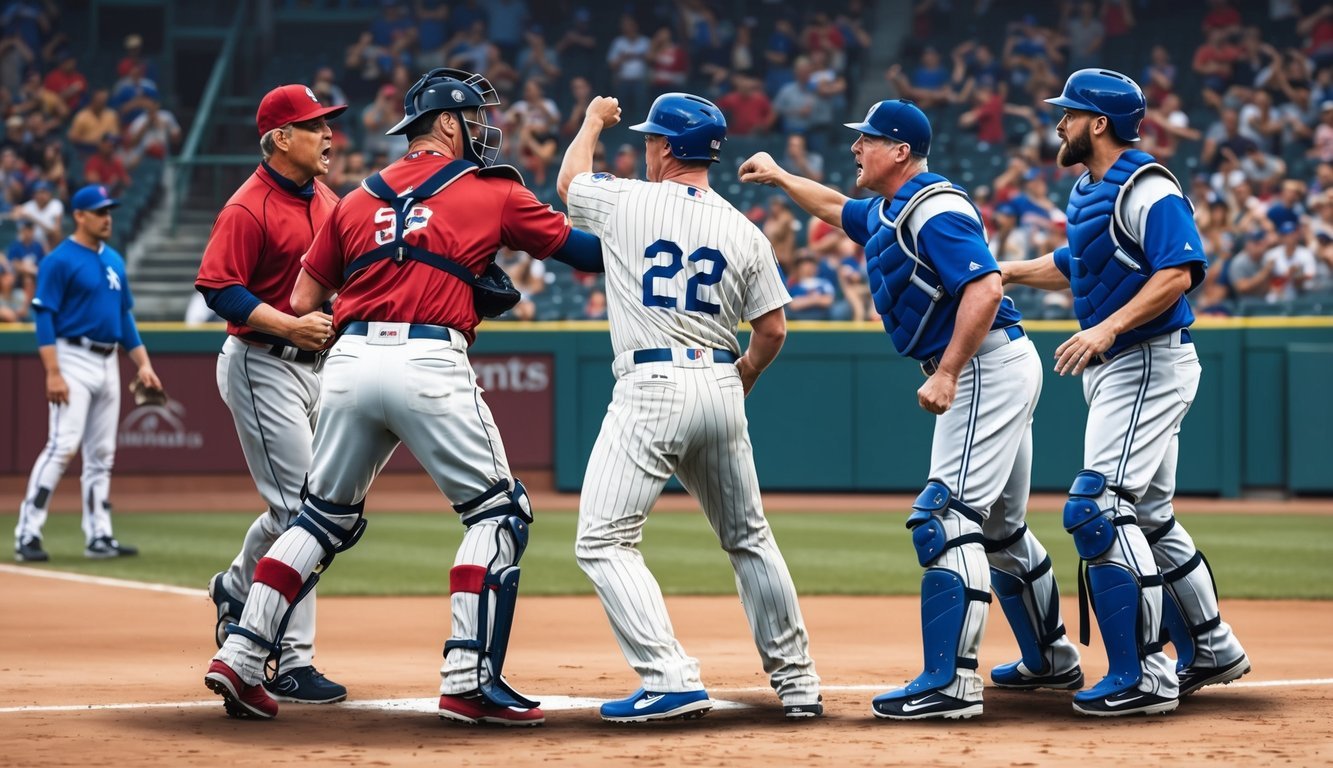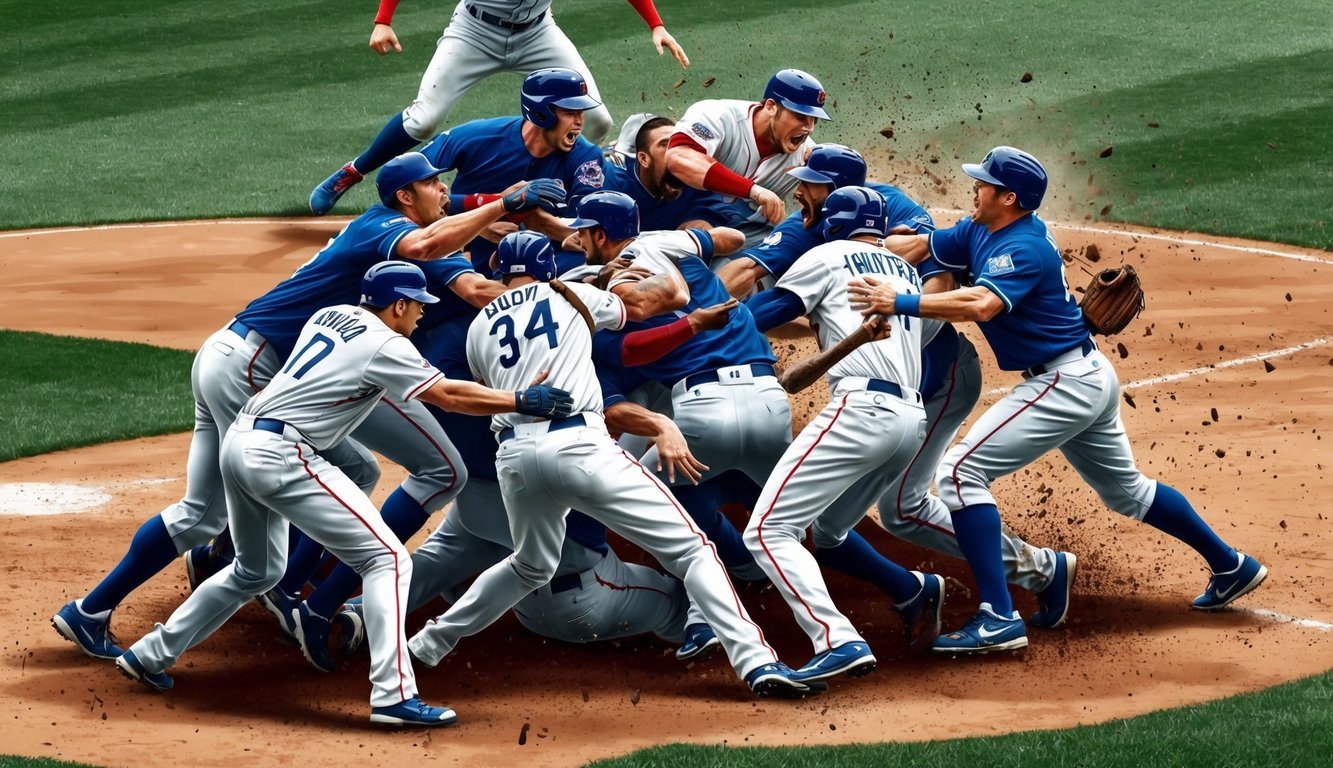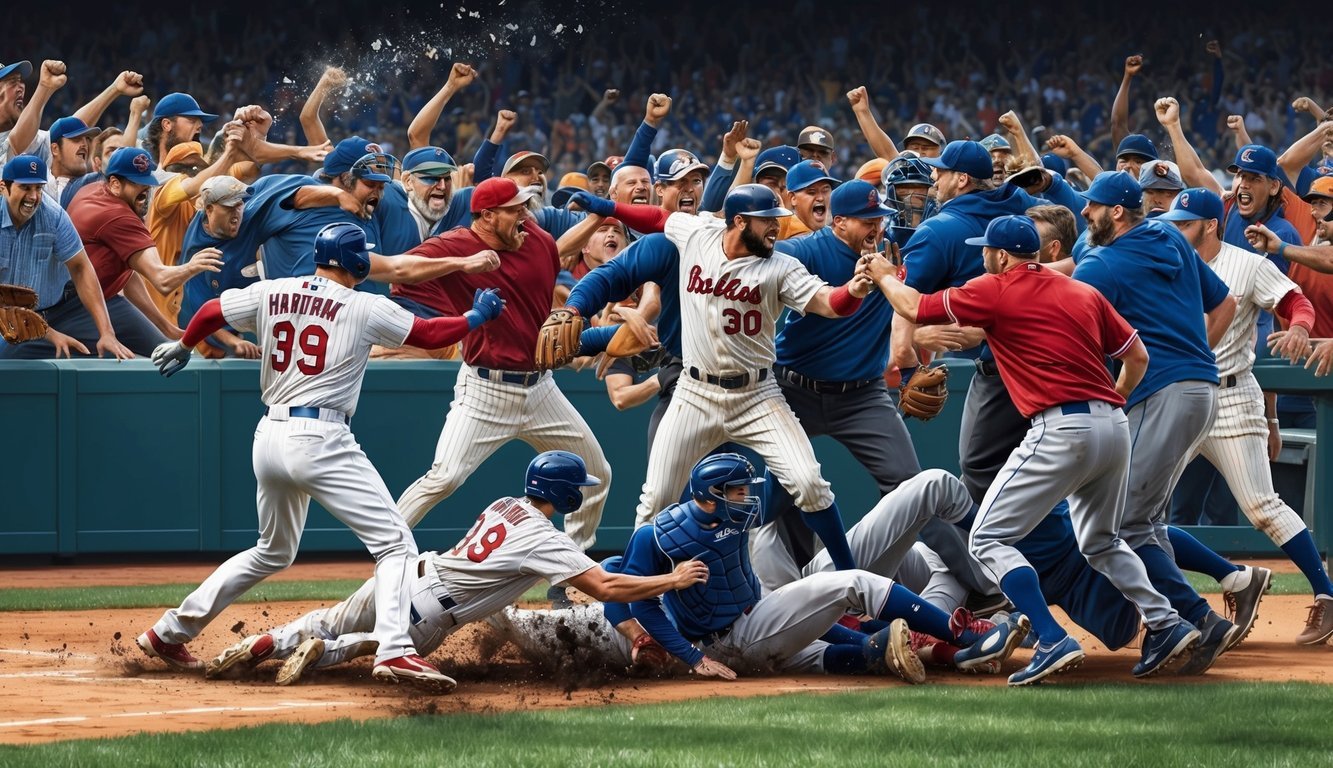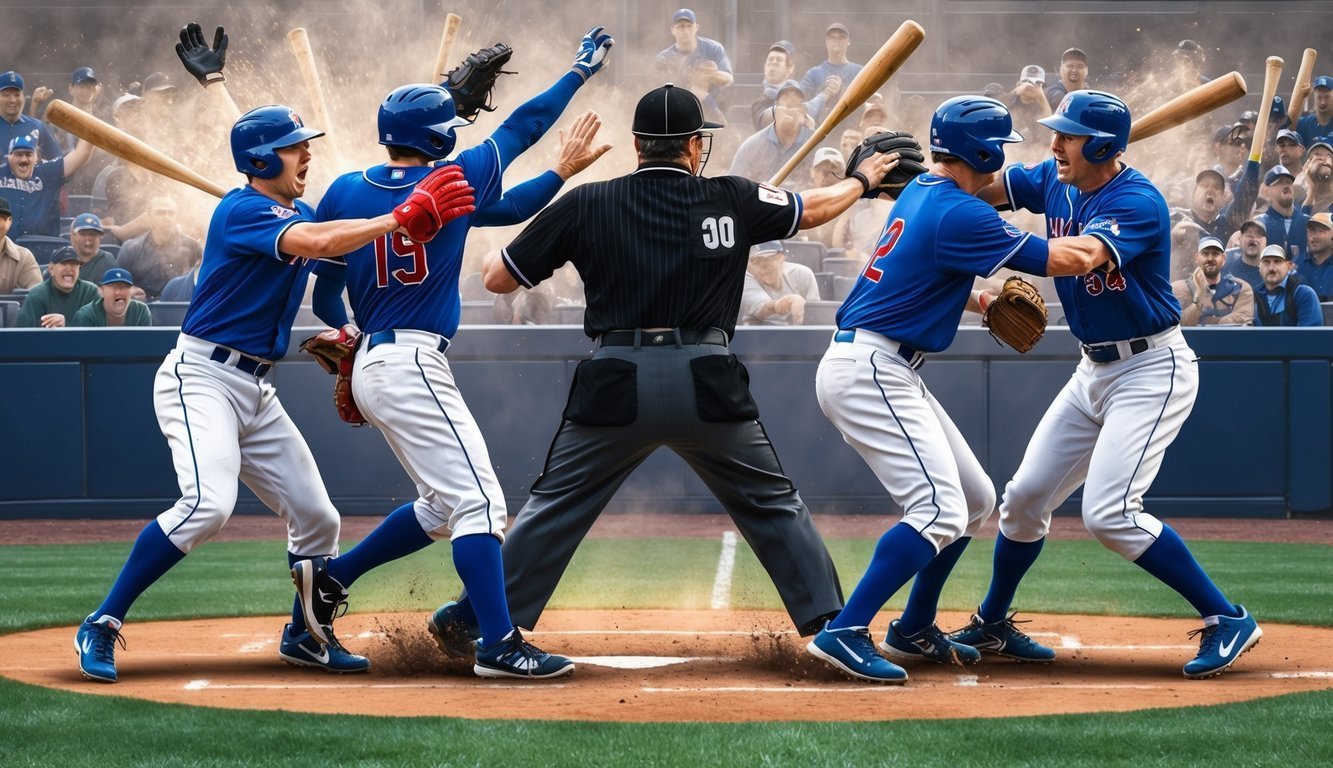Baseball has long been known as America’s pastime, but sometimes tensions on the field boil over into physical altercations.
Recent incidents in Major League Baseball have reminded fans that even in a non-contact sport, emotions can run high.
Baseball fights often stem from perceived violations of the unwritten rules of the game, such as hard slides, bat flips, or pitches that come too close to a batter.
These confrontations can range from shoving matches to full-scale brawls involving both teams.
While rare, they capture attention and spark debates about sportsmanship and tradition.
MLB takes these incidents seriously, typically issuing suspensions and fines to players and coaches involved.
Efforts to curb on-field violence are ongoing, but the competitive nature of professional sports means that heated moments will likely continue to occur, adding an element of unpredictability to America’s favorite game.
Historical Incidents
Baseball has seen its fair share of heated moments on the diamond.
Tempers have flared, leading to memorable clashes between players and teams over the years.
Famous Baseball Brawls
The 1984 brawl between the San Diego Padres and Atlanta Braves stands out as one of the most intense in MLB history.
It started when Pascual Perez hit Alan Wiggins with the first pitch of the game.
The incident sparked multiple fights throughout the contest, resulting in numerous ejections.
Another notorious altercation occurred in 1998 when Armando Benitez of the Orioles hit Tino Martinez of the Yankees.
This led to a bench-clearing brawl that spilled into the dugout.
Players exchanged punches, and several suspensions followed.
The 1965 incident between Juan Marichal and John Roseboro is often cited as one of the ugliest in baseball.
Marichal, wielding a bat, struck Roseboro in the head during an argument at home plate.
The Role of Rivalries
Intense rivalries have often fueled baseball fights.
The Yankees-Red Sox rivalry has produced several heated exchanges over the years.
One notable incident occurred in 2003 when Pedro Martinez threw Don Zimmer to the ground during a playoff game.
The Dodgers-Giants rivalry has also seen its share of brawls.
Their long-standing animosity dates back to their days in New York and has carried over to the West Coast.
Rivalries tend to intensify emotions on the field.
Players are more likely to take offense to perceived slights or aggressive play when facing a rival team.
This heightened tension can lead to more frequent confrontations and bench-clearing incidents.
Rules and Regulations
Baseball has strict policies governing player conduct on the field, especially regarding fights and unsportsmanlike behavior.
Umpires play a crucial role in enforcing these rules and maintaining order during games.
Ejection and Suspension Policies
Players involved in fights face immediate ejection from the game.
Umpires have the authority to remove any participant engaging in violent or unsportsmanlike conduct.
Ejected players must leave the dugout and playing area.
Suspensions often follow ejections for fighting.
The length of suspension depends on the severity of the incident and the player’s role.
Repeat offenders typically face harsher penalties.
Team managers can also be ejected for their players’ actions or their own misconduct.
Suspended individuals are not allowed in the dugout or press box during games.
Consequences for Fighting
Fighting in baseball carries serious consequences beyond ejections.
Players may face fines, extended suspensions, and damage to their reputation.
MLB reviews fight incidents and can issue additional penalties.
Suspensions without pay can be costly for players, especially stars with high salaries.
Teams may suffer from losing key players for multiple games.
This can impact their performance and standings in the league.
Public image is another consideration.
Fighting incidents often receive negative media attention, potentially affecting a player’s endorsements and fan support.
Umpire’s Authority
Umpires have broad powers to maintain order on the field.
They can issue warnings to players and teams for aggressive behavior or potential retaliation.
If tensions rise, umpires may warn both benches to prevent further escalation.
Ignoring these warnings can lead to automatic ejections.
Umpires can eject players without prior warning for severe infractions.
Their decisions are typically final, though teams may appeal suspensions to the league office.
In extreme cases, umpires have the authority to forfeit games if a team fails to control its players or follow directives to restore order on the field.
Notable Players and Managers

Baseball fights often involve key figures on the field and in the dugout.
Players and managers play crucial roles in escalating or defusing tensions during heated moments.
Roles in Conflicts
Players are typically at the center of baseball fights.
Pitchers sometimes spark conflicts by throwing at batters.
Position players may retaliate with charged mound visits.
Tim Anderson of the Chicago White Sox has been involved in several notable altercations, including a 2023 brawl with José Ramírez of the Cleveland Guardians.
Catchers often act as peacemakers, stepping between pitchers and charging batters.
Veteran players sometimes try to calm younger teammates.
In bench-clearing incidents, relief pitchers sprint in from the bullpen to join the fray.
Managerial Strategies
Managers like Terry Francona and Scott Servais employ various tactics to handle on-field conflicts.
Some rush out to protect their players and argue with umpires.
Others remain calm to set an example for their team.
Phil Nevin, current manager of the Los Angeles Angels, has shown a fiery approach.
In a 2022 incident, Nevin received a 10-game suspension for his role in a brawl with the Seattle Mariners.
Managers may use fights strategically to motivate their teams or challenge opponents.
However, they risk ejections and suspensions, potentially impacting their teams’ performance.
Recent Conflicts

Baseball has seen its share of heated confrontations in recent years.
Players and coaches have clashed on the field, resulting in ejections, suspensions, and intense rivalries.
These tense moments often ignite the passion of fans, sparking debates about the spirit of the game and sportsmanship.
As teams vie for dominance, the intensity of their matchups can lead to unforgettable moments that are etched in sports lore.
Indeed, baseball rivalry highlights through history showcase not only the competitive nature of the sport but also the lasting bonds and narratives that capture the heart of America’s pastime.
Angels vs. Seattle Mariners Brawl
In June 2022, tensions boiled over between the Los Angeles Angels and Seattle Mariners.
The brawl erupted after Andrew Wantz hit Jesse Winker with a pitch.
Players from both teams rushed onto the field, with Julio Rodriguez and Raisel Iglesias among those involved.
The melee led to eight ejections, including Angels interim manager Phil Nevin.
MLB handed down severe punishments, suspending 12 players and coaches.
Nevin received a 10-game ban for his role in the incident.
Mike Trout and Anthony Rendon were also caught up in the chaos.
The fight spilled into the dugouts, with players throwing sunflower seeds and gum.
Ryan Tepera joined the fray as well.
White Sox and Cleveland Guardians Friction
In August 2023, the Chicago White Sox and Cleveland Guardians engaged in a fierce altercation.
The incident centered around Tim Anderson and José Ramírez at second base.
Tensions escalated quickly when Ramírez landed a punch on Anderson’s jaw.
The benches cleared as players and coaches rushed to join the scuffle.
Emmanuel Clase was among those involved in the ensuing chaos.
The fight resulted in six ejections and multiple suspensions.
It disrupted the game and forced changes to both teams’ lineups.
José Suarez, who was not directly involved, had to adjust his pitching routine due to the delay.
The Role of the Fans

Baseball fans play a crucial part in creating the electric atmosphere at games.
Their cheers and chants fuel the energy on the field, inspiring players to perform at their best.
Sometimes, fan enthusiasm can boil over into confrontations.
In March 2024, a clash between San Francisco Giants and San Diego Padres supporters made headlines.
This incident highlighted how passionate rivalries can spark tension in the stands.
Fans often mirror the emotions displayed on the field.
When benches clear during a heated moment, spectators may become more animated.
Their reactions can amplify the drama unfolding before them.
The bullpen areas, typically close to fan seating, can become focal points for interaction.
Players warming up might hear encouragement or heckling from nearby spectators.
Teams rely on their fan base for support through ups and downs.
Loyal followers stick with their squad through winning streaks and slumps alike.
This unwavering backing creates a special bond between players and fans.
Most importantly, fans embody the spirit of the game.
Their love for baseball keeps the sport thriving, generation after generation.
Whether cheering from the bleachers or watching at home, fans are the heart of America’s pastime.
